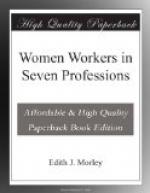Some girls will welcome the larger opportunities for social service which are open to the elementary school-teacher: others will prefer and be better suited to the conditions of the secondary school. Clearly, the student, whose expenses have been defrayed by the Government on condition that she enters its service, must fulfil her undertaking: but that should not in itself limit her to one type of school in these days of grant-aided institutions.[1] The new four-year course makes it possible for her, as for independent students, to train in the year subsequent to taking a degree—an essential reform if the old over-strain and rush are to be avoided. It is generally accepted, and in girls’ secondary schools commonly acted upon, that professional training for one year after graduation, is indispensable. The teacher is born, not made, but she needs help if she is to avoid mistakes equally disastrous to herself and her pupils: she requires some knowledge of child-character, some acquaintance with the history and theory of education, some leisure to formulate, some opportunity to consider the aims as well as the methods of her teaching. We have, perhaps, passed beyond the stage when it is necessary further to discuss the value and effect of training. It is still desirable to emphasise the fact that the untrained woman teacher finds it increasingly difficult to obtain satisfactory and well-paid school posts.[2] Girls should endeavour by every means in their power to secure this fourth year at college, which is essential to their competency and to security of employment. It would also be well to impress on county councils that their work is but half done if they continue to refuse a renewal of scholarships for training to those who have taken a degree.




